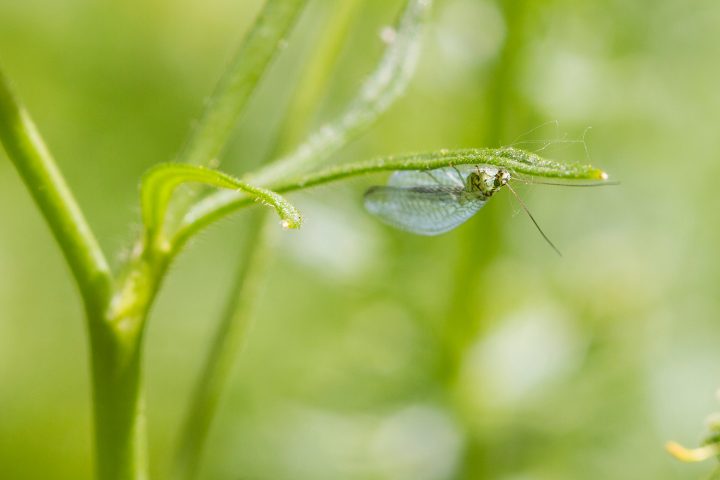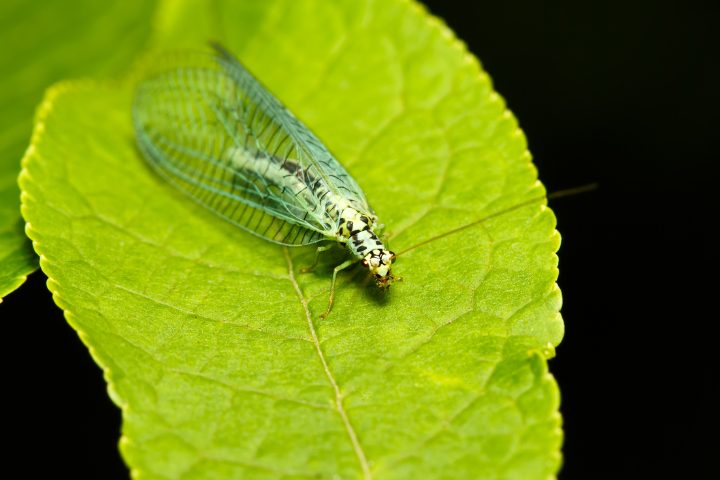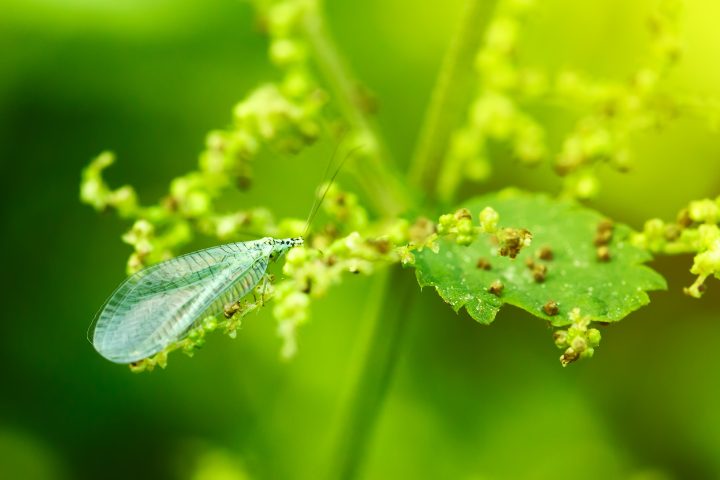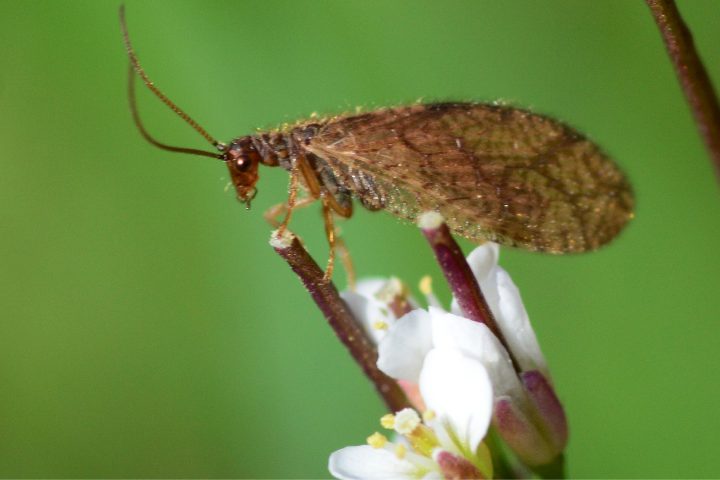Lacewings are one of the most beneficial insects to have in your garden. This guide will show you how to attract lacewings to help get rid of those pesky aphids and other pest infestations.
[toc]
Keeping natural predators in your garden is one of the best ways to control pest populations in the long run. The lacewing is one of the most beneficial insects in this regard.
These generalist predators hunt a variety of garden pests, thus protecting your plants. With adult female lacewings laying 100 to 300 eggs during their lifespan, these predators can multiply rapidly.
This article is for plant parents trying to figure out how to attract lacewings to their gardens.

Plant Flowers in Your Garden
While the lacewing larvae feed on pests, adult lacewings need nectar and pollen to sustain themselves.
You can easily attract these beneficial insects to your garden by planting flat and broad flowers that are rich in nectar and have easily accessible floral disks.
Keep in mind that you need to choose flowering plants that constantly bloom from early spring to late autumn. Some of the flowers that attract lacewings are:
- Sunflowers
- Daisies
- Cosmoses
- Coreopsis
- Goldenrod
- Yarrow
It’s best to plant a diverse range of these flowers to attract lacewings rather than just a single type. Lacewings also happen to be great pollinators and will help your garden grow.
Provide a Source of Water
To turn your garden into an ideal habitat for lacewings, you need to provide them with a place to rehydrate too.
Beneficial insects always prefer to hang around places with a good food source and adequate water. You can fill frisbees, birdbaths, glass casserole dishes, or any other shallow pans with water for them to drink.
However, remember to pile up some pebbles in the pan, as lacewings can’t land directly on the surface of the water. Besides lacewings, this will also help attract parasitic wasps, bees, and butterflies.

Add Some Plants That Attract Lacewings
When trying to draw any specific insect species to your garden, it’s a good idea to add plants that attract them.
Different beneficial insects have different preferences when it comes to plants to live or lay eggs on. Thankfully, you have plenty of options, as adult lacewing is attracted to a wide variety of plants.
In addition to the flowers mentioned earlier, you may also plant the following:
- Tansy
- Coriander
- Dill
- Fennel
- Queen Anne’s Lace
- Angelica
- Fern-leaf yarrow
- Four-wing saltbush
- Dandelion
- Cosmos white sensation
- Caraway
- Golden marguerite
- Purple poppy mallow
- Prairie sunflower
Allow (Small) Aphid Infestations To Happen
While aphids are usually undesirable, allowing small aphid infestations to occur in your garden is a clever way to protect it from aphids in the long run.
An aphid colony in your garden will attract lacewings to lay eggs nearby. They will not only get rid of the existing infestation but will also prevent major aphid infestations in the future.
If there are no lacewings near the aphid colony, you may spray the nearby plants with sugar water to simulate honeydew.
This will draw the attention of aphid lions (lacewing larvae) and eventually lead them to the aphids. You can also use this trick to attract them to small aphid infestations they might have missed during their feeding frenzies.

Don’t Spray Pesticides
You will have to choose between lacewings and pesticides – you can’t have it both ways. While pesticides help eliminate the pests that damage your garden, they also kill beneficial insects.
Hence, the use of pesticides is a big no-no if you are trying to maintain a healthy population of lacewings in your garden.
Instead of pesticides, you may implement organic methods of pest control that won’t harm lacewings.
For instance, using a vacuum cleaner or a hose sprayer are effective ways to get rid of pests without the use of pesticides.
Use Foods That Attract Lacewings and Other Beneficial Insects
For sure, the plants and flowers that attract lacewings and other beneficial insects are of great help.
However, how do you attract lacewings until the plants bloom and can provide them with nectar and pollen to feed on? By providing them with other food sources.

Sugar water spray
Create a sugar water solution by mixing a tablespoon of sugar in a cup of water and spraying it over your plants.
Not only would the lacewings feed on the sugary water, but the solution also simulates the honeydew produced by aphids.
As mentioned earlier, spraying a sugar water solution is a great way to lead lacewings, ground beetles, and lady beetles to aphid colonies.
Homemade wheat
This is another food supplement that does a great job at attracting lacewings and other beneficial insects.
Mix a ¼ cup of brewer’s yeast with an equal quantity of white sugar and add a spoonful of water to it. This should result in a paste, which you can spread on popsicle sticks or wooden sticks.
Now, simply insert these sticks into the soil surrounding the plants.

Beneficial bug food
You can also use generalist bug food that draws not only lacewings but also other beneficial insects. To make it, put half a cup of sugar in 2/3rd cup of warm water, along with two teaspoons of honey and 1/4th cup of brewer’s yeast.
You may also buy such bug food from a garden center if you don’t want to make it yourself.
To use this mixture, you simply have to mix two teaspoons of it per quart of warm water and blend the solution well. Use a spray bottle to spread this solution over your plants.
Frequently Asked Questions
What are green lacewings attracted to?
Like most lacewings, green lacewings are attracted to flowers like the cosmos, marguerite daisies, yarrow, coreopsis, Queen Anne’s lace, and goldenrod.
The presence of pests like aphids will attract them to lay eggs too. You might also consider keeping some source of water in your garden to attract these insects.
Are lacewings good for your garden?
Yes, lacewings are extremely beneficial and would help keep your garden free of pests.
Attracting lacewings to your garden and allowing them to grow in numbers is a great way to control pests without having to use pesticides. Moreover, lacewings also happen to be great pollinators.
Where do lacewings lay their eggs?
Lacewings lay eggs on the undersides of leaves, usually near colonies of other insects that will provide the offspring with a food source during the larval stage.
While the brown lacewings lay their eggs in clusters, green lacewing eggs usually lay suspended on strands of silk.
Plants to attract hoverflies?
Hover flies are another beneficial insect species that can protect your garden from pests. They’re attracted to a diverse range of plants, such as dill, lavender globe lily, common yarrow, caraway, Queen Anne’s lace, etc. As you might notice, most of these plants attract lacewings too.
Wrapping up
As lacewings are abundant in North America, it’ll likely be easy to attract them to your flower garden. However, if you are having a hard time, you may buy lacewing eggs online and place them near food sources.
Green lacewings are especially effective at pest control – each larva can eat up to 200 pests or insect eggs a week.
Hopefully, this article was worth your time, and you won’t have much trouble getting lacewings to visit your garden. Thank you for reading!
Reader Emails
Over the years, our readers have shared their experiences with many of these and other home remedies to attract lacewings to their gardens. Read all about them in our email section below.
Letter 1 – Lacewing from Turkey
I only got a photo of it and don’t know much about this insect. Tried a few sites but couldn’t find anything. (from istanbul/Turkey)
Yalin

Hi Yalin,
This is a Lacewing, a harmless predator. The body is more rubust than the species we find in Southern California.
You got an idea?
Letter 2 – Lacewing from Romania

Letter 3 – Lacewing from Malaysia

Letter 4 – Lacewing, we believe
 Subject: what is this insect Location: Tyler, TX January 7, 2017 8:01 pm I live in Tyler, TX and the temp was about 30 degrees when I took my dog outside. When we came back in, this bug was on my jacket. It is Jan. and I haven’t been seeing many critters, although our temps here jump from winter to spring day by day. By Wed. it will be in the low 70’s again. Tyler is known for its Dogwood trees, Azaleas, roses, etc. etc. This is a portion of TX that gets plenty of rain so, there is much vegetation in the area. The little fellow looked like a small shrimp with translucent wings to me. It appears to have two sets, but I would need to get my jewelry magnifying lamp out and I don’t really have a good place to set it up as I am in the middle of remodeling. It is the color of a shrimp and the head is tiny with a long body. It is approximately a half inch long. Appreciate any info you might have. Signature: Mitzi in Tyler
Subject: what is this insect Location: Tyler, TX January 7, 2017 8:01 pm I live in Tyler, TX and the temp was about 30 degrees when I took my dog outside. When we came back in, this bug was on my jacket. It is Jan. and I haven’t been seeing many critters, although our temps here jump from winter to spring day by day. By Wed. it will be in the low 70’s again. Tyler is known for its Dogwood trees, Azaleas, roses, etc. etc. This is a portion of TX that gets plenty of rain so, there is much vegetation in the area. The little fellow looked like a small shrimp with translucent wings to me. It appears to have two sets, but I would need to get my jewelry magnifying lamp out and I don’t really have a good place to set it up as I am in the middle of remodeling. It is the color of a shrimp and the head is tiny with a long body. It is approximately a half inch long. Appreciate any info you might have. Signature: Mitzi in Tyler


Letter 5 – Lacewing from Puerto Rico
Subject: Bug ID Geographic location of the bug: Puerto Rico, Caribbean Date: 08/16/2021 Time: 12:11 PM EDT Your letter to the bugman: Thank you! How you want your letter signed: Vivian

The post How To Attract Lacewings In 6 Easy Steps appeared first on What's That Bug?.
No comments:
Post a Comment